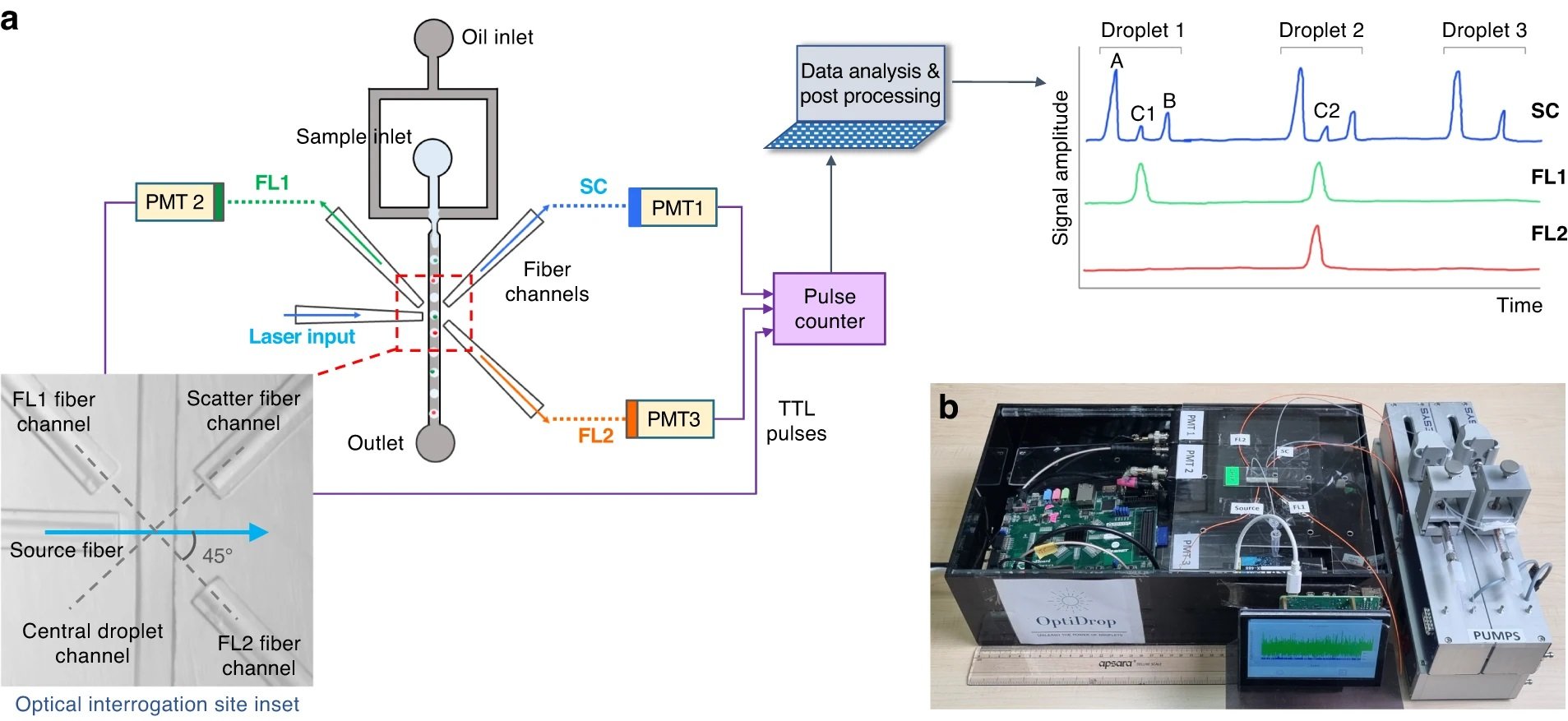
09 Apr Precise Single-Cell Analysis through On-Chip Fiber Optics
The ability to analyze individual cells allows scientists to uncover a wealth of information hidden in the cellular heterogeneity of tissues, leading to breakthroughs in understanding diseases and developing targeted treatments. However, despite the critical importance of this research, traditional methods of single-cell analysis, particularly in droplet microfluidics, have been hampered by technical complexities and prohibitive costs. Enter the OptiDrop platform, a novel technology designed to address these challenges head-on.
“To address these limitations, we developed the OptiDrop platform; this platform is a novel optofluidic setup that leverages the principles of flow cytometry. Our platform enables on-chip detection of the scatter and multiple fluorescence signals from the microfluidic droplets and their contents using optical fibers. The highly customizable on-chip optical fiber-based signal detection system enables simplified, miniaturized, low-cost, multiparametric sensing of optical signals with high sensitivity and single-cell resolution within each droplet.“, the authors explained.
Developed by a team of innovators, the OptiDrop platform leverages on-chip fiber optics to enable the detection of scatter and multiple fluorescence signals from microfluidic droplets and their contents. The OptiDrop platform integrates optical fibers directly onto polydimethylsiloxane (PDMS)-based microfluidic chips, a process achieved through standard soft lithography techniques. This process ensures precise formation of the microfluidic channels necessary for droplet generation and analysis. The incorporation of optical fibers into the chip facilitates the detection of light scattered and fluorescence emitted from within the droplets, streamlining the analysis process. This novel microfluidic device marks a significant departure from conventional microscopy-based imaging and flow cytometry techniques, which are not only technically complex but also come with a hefty price tag.

“a The OptiDrop platform comprises a microfluidic chip with an oil and water inlet for the formation of droplets at the flow-focusing junction. The aqueous phase is encapsulated within droplets and subsequently flows through the optical interrogation site (inset) flanked by a set of optical fiber grooves arranged around the central channel. The grooves on the chip are used to house the optical fibers at set angular positions, allowing for effective droplet illumination with the incident laser light and collection of scattered light and fluorescence signals as the droplet passes through the light beam. The optical fiber output is coupled into a PMT for detection. TTL pulse counts from each PMT are integrated by an FPGA chip with a pulse counter and plotted as raw signal intensity peak data. The raw data can be further analyzed to identify or measure fluorescence intensities from the cells of interest. b Benchtop assembled unit with a foot ruler for scale along with a live data stream viewing screen and syringe pumps” Reproduced from Gupta, P., Mohan, A., Mishra, A. et al. Multiplexed fluorescence and scatter detection with single cell resolution using on-chip fiber optics for droplet microfluidic applications. Microsyst Nanoeng 10, 35 (2024). https://doi.org/10.1038/s41378-024-00665-w. under a CC BY 4.0 DEED Attribution 4.0 International license.
The technical merits of the OptiDrop platform are underscored by its high sensitivity, with a fluorescence detection limit reaching as low as 1 nM for fluorescein, demonstrating superior performance compared to traditional methodologies. Additionally, the system showcases a broad dynamic range of detection spanning from 1 nM to 1 µM for fluorescein in 4 nL droplets, accommodating a wide spectrum of analytical requirements. The platform’s capability to differentiate cells or beads based on size is validated through scatter signal analysis, where beads of 3, 6, and 10 µm sizes exhibited correspondingly distinct scatter signal intensities.
The platform’s utility was exemplified in a study examining the differential expression of major histocompatibility complex (MHC) proteins in response to IFNγ stimulation. OptiDrop enabled the multiparametric analysis of cell surface markers with single-cell resolution, detecting notable increases in MHC protein expression. Specifically, 94% of MHC class I-expressing cells also exhibited MHC class II proteins upon stimulation, showcasing the platform’s capability for detailed cellular analysis.
“The current work provides the foundation for further improvements in the speed, sensitivity, accuracy, and cost of optical sensing of single cells encapsulated in droplets. We hope that the range of applications of the OptiDrop platform will be further extended and that it will enable the development of affordable, scalable benchtop droplet microfluidic solutions in biomedical research and diagnostics.“, the authors concluded.
Figures are reproduced from Gupta, P., Mohan, A., Mishra, A. et al. Multiplexed fluorescence and scatter detection with single cell resolution using on-chip fiber optics for droplet microfluidic applications. Microsyst Nanoeng 10, 35 (2024). https://doi.org/10.1038/s41378-024-00665-w under a CC BY 4.0 DEED Attribution 4.0 International license.
Read the original article: Multiplexed fluorescence and scatter detection with single cell resolution using on-chip fiber optics for droplet microfluidic applications
For more insights into the world of microfluidics and its burgeoning applications in biomedical research, stay tuned to our blog and explore the limitless possibilities that this technology unfolds. If you need high quality microfluidics chip for your experiments, do not hesitate to contact us.


